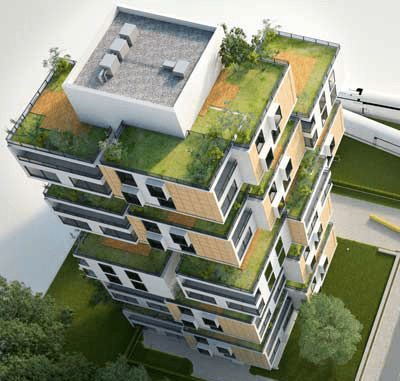Anushka Rudrabhate
Dr. B. N. College of Architecture, Pune, India
Corresponding Author: es2109.anushkar@bnca.ac.in
Prajakta Dalal-Kulkarni
Dr. B. N. College of Architecture, Pune, India
Highlights
- Urban Building Energy Modelling (UBEM) is used to study embodied energy in urban redevelopment scenarios.
- In comparison with existing and conventional 2030 scenarios, the low-carbon 2030 scenario had lower embodied energy (EE) and Embodied carbon (EC).
- Choosing low-carbon materials and optimizing massing layouts play a crucial role in reducing total embodied carbon in the building stock.
Abstract
Building construction accounted for more than 40% of global energy consumption and 30% of greenhouse gas emissions. It is essential to understand embodied carbon in buildings at the neighbourhood level, as after construction, it will be locked there for several years. This study aims to analyze the embodied energy (EE) of the neighbourhood for redevelopment scenarios using (UBEM). The study area chosen was Rasta Peth, Pune. The primary sources of embodied energy were discovered by analyzing existing dense neighbourhoods. Massing cases for redevelopment scenarios were created according to UDCPR guidelines. A comparative analysis of EE between the redeveloped 2030 scenarios was conducted. The research results show that the low carbon 2030 scenario has 27.9% lower EE than the conventional scenario. The findings emphasized the importance of embodied energy in sustainability strategies for urban planners and policymakers. This research contributed valuable insights for reducing embodied energy in urban areas.
Keywords
Embodied Energy, Neighbourhood, Redevelopment, Urban Building Energy Modelling (UBEM)
References
- S. Maurya, “Carbon emission reduction of redevelopment projects through construction and demolition waste,” no. October, pp. 0-10, 2022. https://doi.org/10.5281/zenodo.7189328
- B. S. Sudhakar, “USF Scholarship : a digital repository @ Gleeson Library | Geschke Reduction of embodied carbon in buildings through use of low carbon strategies and standardization and enforcement of Life Cycle Assessment This Master’s project Master of Science Univer,” 2022.
- F. Renard, L. Alonso, Y. Fitts, A. Hadjiosif, and J. Comby, “Evaluation of the effect of urban redevelopment on surface urban heat islands,” Remote Sens., vol. 11, no. 3, pp. 1-31, 2019. https://doi.org/10.3390/rs11030299
- C. Cerezo Davila, C. F. Reinhart, and J. L. Bemis, “Modeling Boston: A workflow for the efficient generation and maintenance of urban building energy models from existing geospatial datasets,” Energy, vol. 117, pp. 237-250, 2016. https://doi.org/10.1016/j.energy.2016.10.057
- A. Rauf, “Reducing Life Cycle Embodied Energy of Residential Buildings: Importance of building and material service life,” Buildings, vol. 12, no. 11, pp. 1-24, 2022. https://doi.org/10.3390/buildings12111821
- W. Zhou, A. Moncaster, E. O’Neill, D. M. Reiner, X. Wang, and P. Guthrie, “Modelling future trends of annual embodied energy of urban residential building stock in China,” Energy Policy, vol. 165, 2022. https://doi.org/10.1016/j.enpol.2022.112932
- N. Anderson, G. Wedawatta, I. Rathnayake, N. Domingo, and Z. Azizi, “Embodied energy consumption in the residential sector: A case study of affordable housing,” Sustain., vol. 14, no. 9, pp. 1-18, 2022. https://doi.org/10.3390/su14095051
- P. J. Davies, S. Emmitt, and S. K. Firth, “Delivering improved initial embodied energy efficiency during construction,” Sustain. Cities Soc., vol. 14, pp. 267-279, 2015. https://doi.org/10.1016/j.scs.2014.09.010.
- I. E. Agency and W. E. Outlook, “World Energy Outlook 2019,” World Fig., pp. 32-32, 2019, [Online]. Available: https://doi.org/10.1787/caf32f3b-en.
- A. 57 International Energy Agency, IEA, Subtask 2: A Literature Review, no. August. 2016. [Online]. Available: http://www.iea-ebc.org/Data/publications/EBC_Annex_57_ST2_Literature_Review.pdf
- N. Buckley, G. Mills, S. Letellier-Duchesne, and K. Benis, “Designing an energy-resilient neighbourhood using an urban building energy model,” Energies, vol. 14, no. 15, pp. 1-17, 2021. https://doi.org/10.3390/en14154445
- R. Buffat, A. Froemelt, N. Heeren, M. Raubal, and S. Hellweg, “Big data GIS analysis for novel approaches in building stock modelling,” Appl. Energy, vol. 208, pp. 277-290, 2017. https://doi.org/10.1016/j.apenergy.2017.10.041
- C. Cerezo, J. Sokol, S. AlKhaled, C. Reinhart, A. Al-Mumin, and A. Hajiah, “Comparison of four building archetype characterization methods in urban building energy modeling (UBEM): A residential case study in Kuwait City,” Energy Build., vol. 154, pp. 321-334, 2017. https://doi.org/10.1016/j.enbuild.2017.08.029.
- C. F. Reinhart, T. Dogan, J. A. Jakubiec, T. Rakha, and A. Sang, “UMI – An urban simulation environment for building energy use, daylighting and walkability,” Proc. BS 2013 13th Conf. Int. Build. Perform. Simul. Assoc., no. July 2014, pp. 476-483, 2013. https://doi.org/10.26868/25222708.2013.1404
- B. Cohen, “Urbanization in developing countries: Current trends, future projections, and key challenges for sustainability,” Technol. Soc., vol. 28, no. 1-2, pp. 63-80, 2006. https://doi.org/10.1016/j.techsoc.2005.10.005
- K. F. Gotham, Urban redevelopment, past and present, vol. 6. 2001. https://doi.org/10.1016/S1047-0042(01)80003-9
- A. Shenvi and R. H. Slangen, “Enabling smart urban redevelopment in india through floor area ration incentives,” ADB South Asia Work. Pap. Ser., vol. 58, no. 58, 2018, [Online]. Available: http://dx.doi.org/10.22617/WPS189452-2
- H. J. Holtzhausen, “Embodied energy and its impact on architectural decisions,” WIT Trans. Ecol. Environ., vol. 102, pp. 377-385, 2007. https://doi.org/10.2495/SDP070361
- A. Estokova, S. Vilcekova, and M. Porhincak, “Analyzing embodied energy, global warming and acidification potentials of materials in residential buildings,” Procedia Eng., vol. 180, pp. 1675-1683, 2017. https://doi.org/10.1016/j.proeng.2017.04.330

 Bishal Thapa
Bishal Thapa





 Fred Sherman
Fred Sherman Sumedha Malaviya
Sumedha Malaviya Satish Kumar
Satish Kumar












 The three main global energy concerns of providing access to modern energy, enhancing the security of the energy supply, and minimising the impact of energy systems on the climate have an impact on both national and international energy governance. To develop solutions that address the many facets of these difficulties, however, a variety of actors and stakeholders must be included due to the complexity of the energy challenges.
The three main global energy concerns of providing access to modern energy, enhancing the security of the energy supply, and minimising the impact of energy systems on the climate have an impact on both national and international energy governance. To develop solutions that address the many facets of these difficulties, however, a variety of actors and stakeholders must be included due to the complexity of the energy challenges. Cities are responsible for more than 70% of the world’s energy consumption and 40% to 50% of its greenhouse gas emissions. Managing increasing urbanisation is a challenge, and nations must deal with the effects it will have on the environment in terms of energy and climate.
Cities are responsible for more than 70% of the world’s energy consumption and 40% to 50% of its greenhouse gas emissions. Managing increasing urbanisation is a challenge, and nations must deal with the effects it will have on the environment in terms of energy and climate. Our transition to a future with lower carbon emissions depends heavily on buildings. They are our places of residence, rest, and employment; they also account for around one-third of the world’s greenhouse gas emissions and nearly 40% of the world’s energy usage.
Our transition to a future with lower carbon emissions depends heavily on buildings. They are our places of residence, rest, and employment; they also account for around one-third of the world’s greenhouse gas emissions and nearly 40% of the world’s energy usage.